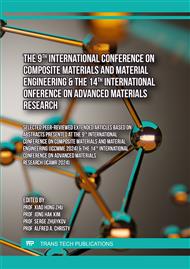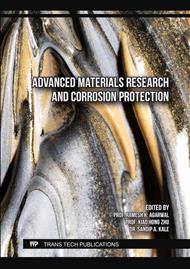[1]
Kannojiya V, Kumar S, Kanwar M, Mohapatra S K. (2016) Simulation of erosion wear in slurry pipe line using CFD. Applied Mechanics and Materials.852:459-65.
DOI: 10.4028/www.scientific.net/amm.852.459
Google Scholar
[2]
Banakermani M R, Naderan H, Saffar-Avval M. (2018) An investigation of erosion prediction for 15 to 90 elbows by numerical simulation of gas-solid flow. Powder Technology. 334:9-26.
DOI: 10.1016/j.powtec.2018.04.033
Google Scholar
[3]
Bilal F S, Sedrez T A, Shirazi S A. (2021) Experimental and CFD investigations of 45 and 90 degrees bends and various elbow curvature radii effects on solid particle erosion. Wear. 476:203646.
DOI: 10.1016/j.wear.2021.203646
Google Scholar
[4]
Elemuren R, Evitts R, Oguocha I, Kennell G, Gerspacher R, Odeshi A. (2018) Slurry erosion-corrosion of 90 AISI 1018 steel elbow in saturated potash brine containing abrasive silica particles. Wear. 410:149-55.
DOI: 10.1016/j.wear.2018.06.010
Google Scholar
[5]
Athulya A S, Cherian R M. (2016) CFD modelling of multiphase flow through T junction. Procedia Technology. 24:325-31.
DOI: 10.1016/j.protcy.2016.05.043
Google Scholar
[6]
Chen X, McLaury B S, Shirazi S A. (2004) Application and experimental validation of a computational fluid dynamics (CFD)-based erosion prediction model in elbows and plugged tees. Computers & Fluids. 33(10):1251-72.
DOI: 10.1016/j.compfluid.2004.02.003
Google Scholar
[7]
Chen X, McLaury B S, Shirazi S A. (2006) Numerical and experimental investigation of the relative erosion severity between plugged tees and elbows in dilute gas/solid two-phase flow. Wear. 261(7-8):715-29.
DOI: 10.1016/j.wear.2006.01.022
Google Scholar
[8]
Wang Q, Huang Q, Wang N, Wen Y, Ba X, Sun X, Zhang J, Karimi S, Shirazi SA. (2021) An experimental and numerical study of slurry erosion behavior in a horizontal elbow and elbows in series. Engineering Failure Analysis. 130:105779.
DOI: 10.1016/j.engfailanal.2021.105779
Google Scholar
[9]
Reddy N.V, Pothal J K, Barik R, Senapati P K. (2023) Pipeline Slurry Transportation System: An Overview. Journal of Pipeline Systems Engineering and Practice. 14(3):03123001.
DOI: 10.1061/jpsea2.pseng-1391
Google Scholar
[10]
Costa A, Nara R. (2020) Computational Fluid Dynamics Erosion Investigation Using Single Objective Adjoint Shape Optimization. Journal of Pipeline Systems Engineering and Practice. 11(3):06020001.
DOI: 10.1061/(asce)ps.1949-1204.0000468
Google Scholar
[11]
Baghel Y K, Patel V K. (2022) Computational investigation of erosion wear in the eco-friendly disposal of the fly ash through 90° horizontal bend of different radius ratios. Chemical Product and Process Modeling.
DOI: 10.1515/cppm-2022-0026
Google Scholar
[12]
Ananya L, Baghel Y K, Patel V K. (2023) Computational Analysis of Erosion Wear in Various Angle Bent Pipes. Materials Today: Proceedings. 80:1150-7.
DOI: 10.1016/j.matpr.2022.12.123
Google Scholar
[13]
Duarte C A, de Souza F J. (2017) Innovative pipe wall design to mitigate elbow erosion: A CFD analysis. Wear. 380:176-90.
DOI: 10.1016/j.wear.2017.03.015
Google Scholar
[14]
Dos Santos V F, de Souza F J, Duarte C A. (2016) Reducing bend erosion with a twisted tape insert. Powder Technology. 301:889-910.
DOI: 10.1016/j.powtec.2016.07.020
Google Scholar
[15]
Zhu H, Li S. (2018) Numerical analysis of mitigating elbow erosion with a rib. Powder technology. 330:445-60.
DOI: 10.1016/j.powtec.2018.02.046
Google Scholar
[16]
Kumar J, Baghel Y K, Tiwari G, Rawat A, Patel V K. (2020) Effect of swirl vanes angle on erosion behaviour of AISI 316 pipe bend. Materials Today: Proceedings. 26:781-6.
DOI: 10.1016/j.matpr.2020.01.026
Google Scholar
[17]
Brown G J. (2002) Erosion prediction in slurry pipeline tee-junctions. Applied mathematical modelling. 26(2):155-70.
DOI: 10.1016/s0307-904x(01)00053-1
Google Scholar
[18]
Mishra R, Singh S N, Seshadri V. (1998) Pressure drop across conventional and diverging-converging pipe bends in the flow of multi-sized particulate slurries.
Google Scholar
[19]
Edwards J K, McLaury B S, Shirazi S A. (2001) Modeling solid particle erosion in elbows and plugged tees. J. Energy Resour. Technol. 123(4):277-84.
DOI: 10.1115/1.1413773
Google Scholar
[20]
Zeng L, Zhang G A, Guo X P. (2014) Erosion–corrosion at different locations of X65 carbon steel elbow. Corrosion Science. 85:318-30.
DOI: 10.1016/j.corsci.2014.04.045
Google Scholar



